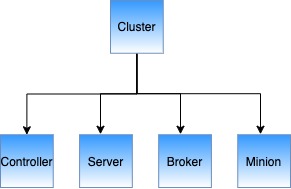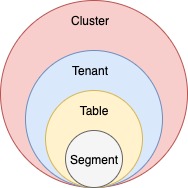Cluster
Learn to build and manage Apache Pinot clusters, uncovering key components for efficient data processing and optimized analysis.
A cluster is a set of nodes comprising of servers, brokers, controllers and minions.

Pinot uses Apache Helix for cluster management. Helix is a cluster management framework that manages replicated, partitioned resources in a distributed system. Helix uses Zookeeper to store cluster state and metadata.
Cluster configuration
For details of cluster configuration settings, see Cluster configuration reference.
Cluster components
Helix divides nodes into logical components based on their responsibilities:
Participant
Participants are the nodes that host distributed, partitioned resources
Pinot servers are modeled as participants. For details about server nodes, see Server.
Spectator
Spectators are the nodes that observe the current state of each participant and use that information to access the resources. Spectators are notified of state changes in the cluster (state of a participant, or that of a partition in a participant).
Pinot brokers are modeled as spectators. For details about broker nodes, see Broker.
Controller
The node that observes and controls the Participant nodes. It is responsible for coordinating all transitions in the cluster and ensuring that state constraints are satisfied while maintaining cluster stability.
Pinot controllers are modeled as controllers. For details about controller nodes, see Controller.
Logical view
Another way to visualize the cluster is a logical view, where:

Set up a Pinot cluster
Typically, there is only one cluster per environment/data center. There is no need to create multiple Pinot clusters because Pinot supports tenants.
To set up a cluster, see one of the following guides:
Was this helpful?

